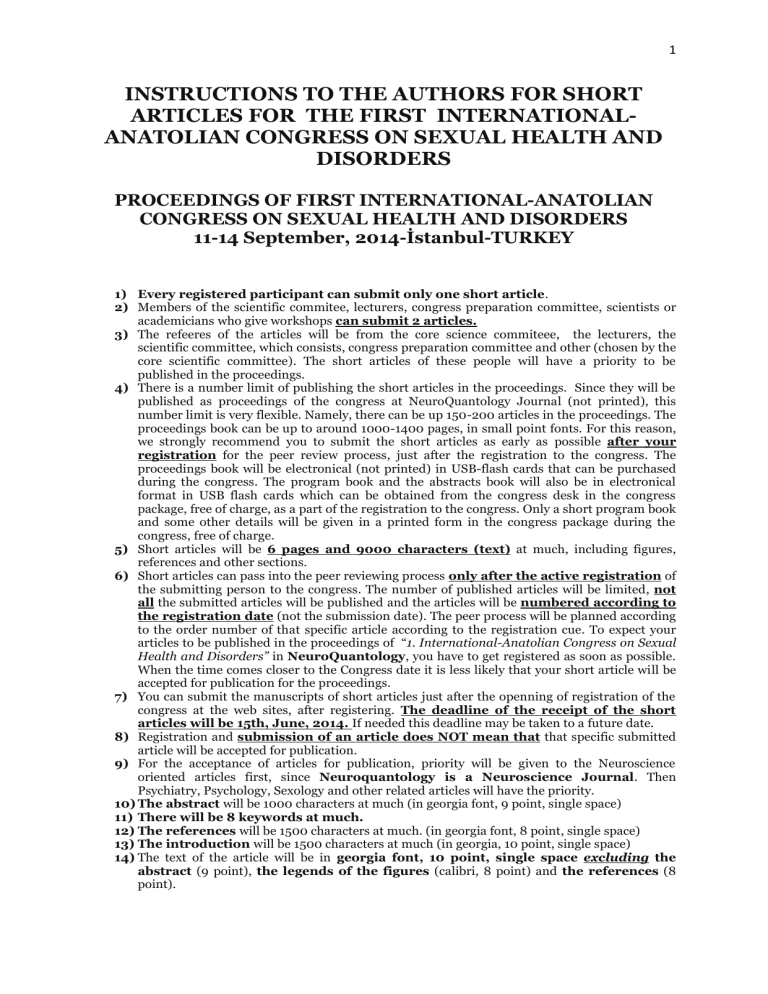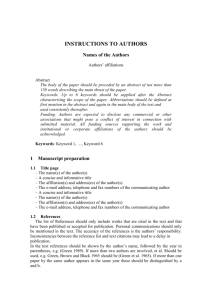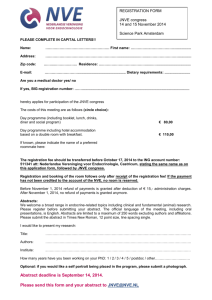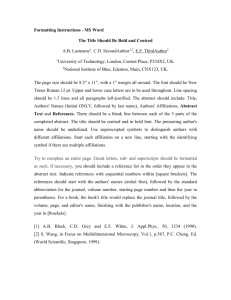Articles - postponıng to may, 1

1
INSTRUCTIONS TO THE AUTHORS FOR SHORT
ARTICLES FOR THE FIRST INTERNATIONAL-
ANATOLIAN CONGRESS ON SEXUAL HEALTH AND
DISORDERS
PROCEEDINGS OF FIRST INTERNATIONAL-ANATOLIAN
CONGRESS ON SEXUAL HEALTH AND DISORDERS
11-14 September, 2014-İstanbul-TURKEY
1) Every registered participant can submit only one short article.
2) Members of the scientific commitee, lecturers, congress preparation committee, scientists or academicians who give workshops can submit 2 articles.
3) The refeeres of the articles will be from the core science commiteee, the lecturers, the scientific committee, which consists, congress preparation committee and other (chosen by the core scientific committee). The short articles of these people will have a priority to be published in the proceedings.
4) There is a number limit of publishing the short articles in the proceedings. Since they will be published as proceedings of the congress at NeuroQuantology Journal (not printed), this number limit is very flexible. Namely, there can be up 150-200 articles in the proceedings. The proceedings book can be up to around 1000-1400 pages, in small point fonts. For this reason, we strongly recommend you to submit the short articles as early as possible after your
registration for the peer review process, just after the registration to the congress. The proceedings book will be electronical (not printed) in USB-flash cards that can be purchased during the congress. The program book and the abstracts book will also be in electronical format in USB flash cards which can be obtained from the congress desk in the congress package, free of charge, as a part of the registration to the congress. Only a short program book and some other details will be given in a printed form in the congress package during the congress, free of charge.
5) Short articles will be 6 pages and 9000 characters (text) at much, including figures, references and other sections.
6) Short articles can pass into the peer reviewing process only after the active registration of the submitting person to the congress. The number of published articles will be limited, not
all the submitted articles will be published and the articles will be numbered according to
the registration date (not the submission date). The peer process will be planned according to the order number of that specific article according to the registration cue. To expect your articles to be published in the proceedings of “1. International-Anatolian Congress on Sexual
Health and Disorders” in NeuroQuantology, you have to get registered as soon as possible.
When the time comes closer to the Congress date it is less likely that your short article will be accepted for publication for the proceedings.
7) You can submit the manuscripts of short articles just after the openning of registration of the congress at the web sites, after registering. The deadline of the receipt of the short
articles will be 15th, June, 2014. If needed this deadline may be taken to a future date.
8) Registration and submission of an article does NOT mean that that specific submitted article will be accepted for publication.
9) For the acceptance of articles for publication, priority will be given to the Neuroscience oriented articles first, since Neuroquantology is a Neuroscience Journal. Then
Psychiatry, Psychology, Sexology and other related articles will have the priority.
10) The abstract will be 1000 characters at much (in georgia font, 9 point, single space)
11) There will be 8 keywords at much.
12) The references will be 1500 characters at much. (in georgia font, 8 point, single space)
13) The introduction will be 1500 characters at much (in georgia, 10 point, single space)
14) The text of the article will be in georgia font, 10 point, single space excluding the
abstract (9 point), the legends of the figures (calibri, 8 point) and the references (8 point).
2
15) The figures will be in jpg and will be placed into the article by the author. Figures should not exceed 3 pages without the text. Each figure will be put into 1 column 2 line TABLE, in the first line the figure should be placed. In the second line legend should be written in calibri font, 8 point, single space.
16) The whole article, will be sent to us in .rtf or .docx format by e-mail to: sexologycongress2014@gmail.com
or to humitsayin@gmail.com
17) Before the submission you have to double check the articles’ spelling mistakes and/or grammer mistakes by using microsoft word’s grammer and spell check function. The reference format sample is given below, the articles that are not submitted following these rules may be rejected without the peer review.
18) You will be notified whether your article is accepted for publication until 1 st -15 th August, 2014.
You may not receive the referee’s comments to accelarate the publication process, but you may receive only an e-mail of notification whether your article is accepted or not.
19) If you are not sure of some of the rules and if you have further questions, please contact: sexologycongress2014@gmail.com
or SKYPE: congress.2014
SAMPLE OF THE FORMAT OF REFERENCES:
Fisher S. Female Orgasm, New York: Basic Books, 1972.
Fisher S. Understanding the Female Orgasm, London: Penguin Books, 1973-1977.
Glenn J & Kaplan EH. Types of orgasm in women: a critical review and redefinition. J Am Psychoanaly Ass 1968;
16: 549 –564.
Hite S. The Hite Report: A National Study of Female Sexuality. New York: Dell Publishing, 1976.
Hooper R. New Scientist, February 20 th , 2008; 2644:6-7.
Kaplan HS. The New Sex Therapy, New York: Penguin Books, 1981.
King R, Belsky J, Mah K, Binik YM. Are there different types of female orgasms? Arch Sex Behav 2010; 40(5):865-
75.
Kline-Graber G, Graber B. A guide to sexual satisfaction: woman’s orgasm. New York: Fawcett Popular Library.
1975.
Komisaruk BR, Sansone G. Neural pathways mediating vaginal function: The vagus nerves and spinal cord oxytocin. Scandinavian J Psych 2003; 44:241-250.
Komisaruk BR, Whipple B, Crawford A, Grimes S, Liu WC, Kalnin A, Mosier K. Brain activation during vaginocervical self stimulation and orgasm in women with complete spinal cord injury: fMRI evidence of mediation by vagus nerves. Brain Res 2004; 1024:77-88.
Komisaruk BR, Whipple B. Functional MRI of the brain during orgasm in women. Annu Rev Sex Res, 16: 62-86,
2005.
Komisaruk BR, Beyer-Flores C, Whipple B. The Science of Orgasm, Baltimore: John Hopkins University Press,
Krüger TH, Hartmann U, Schedlowski M. Prolactinergic and dopaminergic mechanisms underlying sexual arousal and orgasm in humans.
World J Urol 2005;23(2):130-8.
Krüger TH, Schiffer B, Eikermann M, Haake P, Gizewski E, Schedlowski M. Serial neurochemical measurement of cerebrospinal fluid during the human sexual response cycle. Eur J Neurosci 2006; 24(12):3445-52.
Ladas AK, Beverly W, Perry JD. The G-Spot and other Discoveries About Human Sexuality, New York: Henry
Holtand Company 2005, (first publication 1982).
Mah K, Binik YM. The nature of orgasm: A critical review of major trends. Clin Psych Rev 2001; 6:823-56.
Mah K, Binik YM. Do all orgasms feel alike? Evaluating a two-dimensional model of the orgasm experience across gender and sexual context. J Sex Res 2002; 39:104113.
Mah K, Binik YM. Are orgasms in the mind or the body? Psychosocial versus physiological correlates of orgasmic pleasure and satisfaction. J Sex & Marital Ther 2005; 31:187-2005.
Masters W, Johnson V. Human Sexual Response, Boston: Little Brown Company, 1966.
Masters W, Johnson V. Human Sexual Inadequacy, Boston: Little Brown and Company, 1970.
Masters W, Johnson V, Kolodny RC. Human Sexuality (textbook), New York: Harper Collins, 1995.
THE ORIGINAL INSTRUCTIONS TO THE AUTHOR SECTION OF
NEUROQUANTOLOGY JOURNAL http://www.neuroquantology.com/index.php/journal/about/submissions#onlineSubmissions
Introduction
3
NeuroQuantology (ISSN 1303-5150) is a journal dedicated to supporting the interdisciplinary exploration of the nature of quantum physics and its relation to the nervous system. Interdisciplinary discussions are particularly encouraged. Contributions must be only English.
Types of contribution
NeuroQuantology is committed to offering readers a stimulating mixture of reviews, original articles, short communications, perspectives and tutorials. Reviews, written by leading experts, summarize the important results of recent research within the journal scope. Communications are critically selected to report on the latest significant research results. Articles are comprehensive, fully documented reports of original research
(see below for details). The journal highlights joint contributions by neuroscientist and physicists and fosters interdisciplinary research.
Review articles
Review articles should be complete, critical evaluations of the existing state of knowledge in a particular topic or area within the scope of the journal. Rather than a 'collage' of detailed information with a complete literature survey, a critically selected treatment of the material is desired; unsolved problems and possible developments should also be discussed. The introduction of a review article should primarily introduce the non-specialist to the subject as clearly as possible. A review should conclude with a section entitled
'Summary and outlook' in which the achievements of and new challenges for the subject are outlined succinctly. Length: a review article manuscript should consist of a maximum of 30 pages of text, footnotes, literature citations, tables and legends (about 25,000 words); there should be no more than 20 references.
Articles (original research papers)
Articles should be comprehensive, fully documented reports of original research. They should be concise but with complete results and conclusions. Authors are encouraged to take advantage of the Web features available (including 3D animations, video and sound). Manuscripts should be divided into the following sections, each beginning on a new page: Title page, Abstract, Introduction, Materials and methods, Results and discussion, Conclusion and outlook, Acknowledgments, Abbreviations list, References, Figure legends,
Tables, Glossary.
Abstract
Articles have an abstract, separate from the text, of up to 250 words and that should not contain any references, numbers, abbreviations, or acronyms unless absolutely necessary. The abstract should give readers concise information about the content of the article. It should not only indicate the general scope of the article but also state the main results obtained and conclusions drawn. When preparing their abstracts, authors should keep in mind that this summary is aimed at an interdisciplinary audience which includes readers outside of their field.
Introduction
An introduction of up to 500 words should include a statement explaining the motivation for the research and should accurately place the investigations in context with previous or current work in the field.
Experimental section
This section provides a clear, unambiguous description of methods, materials and equipment in sufficient detail to permit reproduction of the work. Please note that communications, which are preliminary reports of original significant research results, should keep experimental details to a minimum.
4
Results and discussion
These sections should present the results and interpret them in a clear and concise manner.
Conclusion and outlook
This last section should outline succinctly the results, present possible important applications of the work, suggestions for future research studies, and reflections on new challenges for the subject.
Opinion and Perspectives
Perspectives should present a personal view on a topic within the scope of the journal. Keywords should be provided by the author(s). These articles may contain topical, historical or biographical information on relevant research, technologies and future research needs. We encourage authors to provide suitable illustrations.
Tutorials
Tutorials are aimed at giving some background knowledge about a particular topic to an audience unfamiliar with the subject covered. These articles may contain historical or biographical information on relevant research and technologies. Authors are encouraged to take advantage of the Web features available
(including 3D animations, video and sound).
Guidelines for the Preparation of Manuscripts
How to prepare your article, Please make note of the following:
Article title:
The title should clearly and concisely reflect the content of the article. Titles are very important for current awareness and information retrieval and therefore should be carefully constructed for these purposes.
Keywords:
All authors are required to provide up to five keywords characterizing the topic of their article.
Names and addresses:
For multiple-authored articles list the names and affiliations of all the authors, the email address(es), the full postal addresses, using identifiers to link an author with an address where necessary.
5
References and footnotes
The accuracy of references is the responsibility of the author. In the text body: (first article author name, year; second references Author name, Year like as Einstein, 1905; Eccles, 1967). Reference should be limited to essential literature. They should be listed at the end of the paper in alphabetical order and not numbered.
For multiple publications by the same author, those by the author alone are listed first, those with two authors listed after these and any with three or more authors must be given up to a maximum of six and any more should be indicated by et al. If there is more than one paper for a given year, these should be listed a, b, c, etc. The references should be presented in the Vancouver style (Uniform requirements for manuscripts, Ann Intern Med 1997;126:36-47 ) and journal titles given in their abbreviated forms. If there are three or more authors, the name of the first is followed by et al. The punctuation in the text, should follow the style of the journal. Examples of reference style:
Auger RG, Daube JR, Gomez MR, Lambert EH. Hereditary form of sustained muscle activity of peripheral nerve origin causing generalized myokymia and muscle stiffness. Ann Neurol 1984; 15: 13–21.
Bushby KMD, Garnder-Medwin D. The clinical, genetic and dystrophin characteristics of Becker muscular dystrophy. Natural history. J Neurol 1993;240: 98- 104.
Mathematics and Symbols
You should take care when writing mathematical articles especially regarding subscripts and superscripts and differentiation between the letter 'l' and the figure one, C and c, S and s, k, K and other similar groups of letters. If your article contains superscripts or subscripts to superscripts or subscripts, take special care to ensure that the positioning of the characters is unambiguous. Exponential expressions, especially those containing subscripts or superscripts, are clearer if you use the notation exp (. . . ) except in the simplest examples. Please use the superscript -1 for reciprocals. It is important to distinguish between ln (= loge) and lg (= log
10
). Multiplication signs should be used in numbers expressed as powers of ten: e.g., 5x10 3 not 5.10
3 .
Figures and tables
You may illustrate your text by line diagrams and photographs. The figures should be clear, easy to read and of good quality. Characters should appear as they would be set in the main body of the article. We will normally use figures as submitted; it is therefore your responsibility to ensure that they are correct.
Figure captions
Authors are required to provide a list of captions describing each figure and identifying the symbols used.
Color illustrations
The use of color in illustrations can enhance the effective presentation of results, and we are pleased to offer free reproduction of color illustrations in the electronic version of NeuroQuantology. There is no charge for color reproduction of illustrations in the electronic version of the journal when the use of color is clearly required to further understanding and communication.
Multimedia
We encourage authors to submit multimedia attachments to enhance the online versions of published research articles. Multimedia enhancements typically consist of video clips, animations or supplementary data such as data files, tables of extra information or extra figures. They can add to the reader's understanding and present results in attractive ways that go beyond what can be presented in the print version of the journal.
6
What files to submit
:: We are able to receive articles prepared using Microsoft Word for Windows (preffered *.doc, *.rtf files)
:: We are able to receive articles prepared using MikTeX and Scientific Workplace (*.TeX file)
:: If special symbols are needed (e.g., Greek characters, accented characters or mathematical symbols) these should be typed using the appropriate TrueType font. Do not use the Symbol facility on the 'Insert' menu as this often results in font conversion problems.
:: Equations must be prepared using Equation Editor, version 1.0, 2.0, 3.0 or MathType.
Adobe Acrobat PDF
The Adobe Acrobat PDF format is suitable for the refereeing process but not the production process.
Figures
Our preferred graphics format is JPEG. These files can be used directly to give high quality results and file sizes are small in comparison with most bitmap forms. Most graphics software has the facility to save as or export as JPEG. Files in most bitmap formats are acceptable, including: *.tiff, *.bmp, and *.jpg.
Multimedia: Video clips and animation
Acceptable formats for video or animation clips are MPEG, QuickTime, Windows AVI or Animated GIF.
Refereeing Process
All contributions that are selected for peer review are sent to two independent reviewers (one reviewer for invited articles). You can track your article situation. ONLINE SUBMISSION and TRACKING SYSTEM...
Proofs
Proofs of articles are usually sent to you for correction by e-mail as an annotated Microsoft word *.doc file attachment. When checking your proofs you should take particular care checking mathematics, tables and references. Only essential corrections should be made.
Please Attention to the Common Errors in Literature Cited
Do not cite abstracts, papers presented at seminars or conferences for which there are no published proceedings unless those papers are accessible online, or papers that are being reviewed by a journal but have not yet been formally accepted for publication. Do not include in Literature Cited publications for which you do not have and cannot obtain the full bibliographic details. Use a carriage return (the enter key) to separate the entries in Literature Cited.
False Phys. Rev. Lett. 2007; 98: 038101.
True Phys Rev Lett 2007; 98: 038101.
False Science, 1999; 285: 1249-1253
True Science 1999; 285: 1249-1253
False Hemley RJ. Turning off the Water, Nature 1995; 378: 14.
True Hemley RJ. Turning off the Water. Nature 1995; 378: 14.
False Wigner, E. P. Physics and Explanations of Life. Foundations of Physics 1970;1:35-45.
True Wigner EP. Physics and Explanations of Life. Foundations of Physics 1970;1:35-45.
False Phillips, R. & Quake, S. R. The Biological Frontier of Physics. Physics Today 2006; 59(5): 38-43.
True Phillips R and Quake SR. The Biological Frontier of Physics. Physics Today 2006; 59(5): 38-43.
False Josephson B. (2002) Beyond quantum theory: a realist psycho-biological interpretation of reality' revisited. BioSystems 44: 43-45.
True Josephson B. Beyond quantum theory: a realist psycho-biological interpretation of reality' revisited.
BioSystems 2002;44: 43-45.
7
Conflict-of-Interest Statement
Authors are expected to disclose any commercial or other associations that might pose a conflict of interest in connection with the submitted article, especially Guideline articles, reports of clinical trials and reports on pharmaceutical products or medical devices. All funding sources supporting the work and the institutional or corporate affiliations of the authors should be acknowledged on the title page. Articles are considered for publication on the understanding that neither the article nor its essential substance has been or will be published elsewhere before appearing in the NeuroQuantology. Abstracts and press reports published in connection with scientific meetings are not considered as publications. The authors should specifically confirm in their cover letter that there has been no ghost writing by anyone not named as a coauthor of the manuscript.
Conflict of Interest Statement for NeuroQuantology
SAMPLE FORM
I hereby disclose all of my conflicts of interest and other potentially conflicting interests, including specific financial interests and relationships and affiliations relevant to NeuroQuantology Journal (eg, employment/affiliation, grants or funding, consultancies, honoraria, stock ownership or stock options, expert testimony, royalties, or patents filed, received, or pending). This applies to the past 5 years and the foreseeable future. I also agree that I will promptly notify the Editor in Chief in writing about any additional potential conflicts of interests that occur.
I agree that I will disqualify myself from reviewing, editing, or participating in editorial decisions about any
NeuroQuantology Journal submission that deals with a matter in which either I or a member of my immediate family (ie, my spouse, domestic partner, or minor children) have direct financial interest or a competing financial interest (eg, employment or affiliation, grants or funding, consultancies, honoraria, stock ownership or stock options, expert testimony, royalties, or patents filed, received, or pending). This also applies to the past 5 years and the foreseeable future.
I also agree that I will not use any confidential information obtained from my activities with
NeuroQuantology Journal to further my own or others financial interests.
_______________________________
Name (please print)
_______________________________
Signature
_______________________________
Date
Please list any potential conflicts of interest:
________________________________________________________
________________________________________________________
Statement of Informed Consent
8
Patients have a right to privacy that should not be infringed without informed consent. Identifying information, including patients' names, initials, or hospital numbers, should not be published in written descriptions, photographs, and pedigrees unless the information is essential for scientific purposes and the patient (or parent or guardian) gives written informed consent for publication. Informed consent for this purpose requires that a patient who is identifiable be shown the manuscript to be published. Authors should identify Individuals who provide writing assistance and disclose the funding source for this assistance.
Identifying details should be omitted if they are not essential. Complete anonymity is difficult to achieve, however, and informed consent should be obtained if there is any doubt. For example, masking the eye region in photographs of patients is inadequate protection of anonymity. If identifying characteristics are altered to protect anonymity, such as in genetic pedigrees, authors should provide assurance that alterations do not distort scientific meaning and editors should so note. When informed consent has been obtained it should be indicated in the published article.
Human and Animal Rights
Depending on the nature of the regarding research, manuscripts submitted for publication in the
NeuroQuantology must contain a statement to the effect that the concerning legally binding ethical standards have been met. Authors are required to check if any of the below statements applies to their submitted work and if necessary, to tick the relevant box and sign the form accordingly.
:: Reports of animal experiments must state that the "Principles of Laboratory Animal Care" (NIH publication No. 85-23, revised 1985) were followed. Moreover authors may have to state that specific national laws (e.g., the current version of the German Law on the Protection of Animals) have been observed, too.
:: All human studies must state that they have been approved by the appropriate ethics committee and have therefore been performed in accordance with the ethical standards laid down in the 1964 Declaration of
Helsinki. The author hereby declares that the research documented in the submitted manuscript has been carried out in accordance with the above stated ethical standards.
Submission Preparation Checklist
As part of the submission process, authors are required to check off their submission's compliance with all of the following items, and submissions may be returned to authors that do not adhere to these guidelines.
1.
The submission has not been previously published, nor is it before another journal for consideration.
2.
The text is single-spaced; uses a 11-point Georgia font; and all illustrations, figures, and tables are placed within the text at the appropriate points, rather than at the end.
3.
The text adheres to the stylistic and bibliographic requirements outlined in the guidelines: "Author
Guidelines"
4.
Mathematics should be prepared using Word’s 'Equation Editor' or the full MathType. Do not use
Word’s "Insert Symbol" command.
5.
All illustrations, figures, and tables are placed within the text at the appropriate points, rather than at the end.
6.
The submission files in Microsoft Word, *.doc, *.docx or *.TeX file (Scientific WorkPlace, MikTeX,
LaTeX2e) format.
Copyright Notice
Copyright of articles is assigned to NeuroQuantology from the date on which the article is accepted for publication. NeuroQuantology permits single copying of single published articles for private study or research, no matter where the copying is done. Authors republish their work for book chapters or their personal homepage without any permission.
Privacy Statement
The names and email addresses entered in this journal site will be used exclusively for the stated purposes of this journal and will not be made available for any other purpose or to any other party.
9







